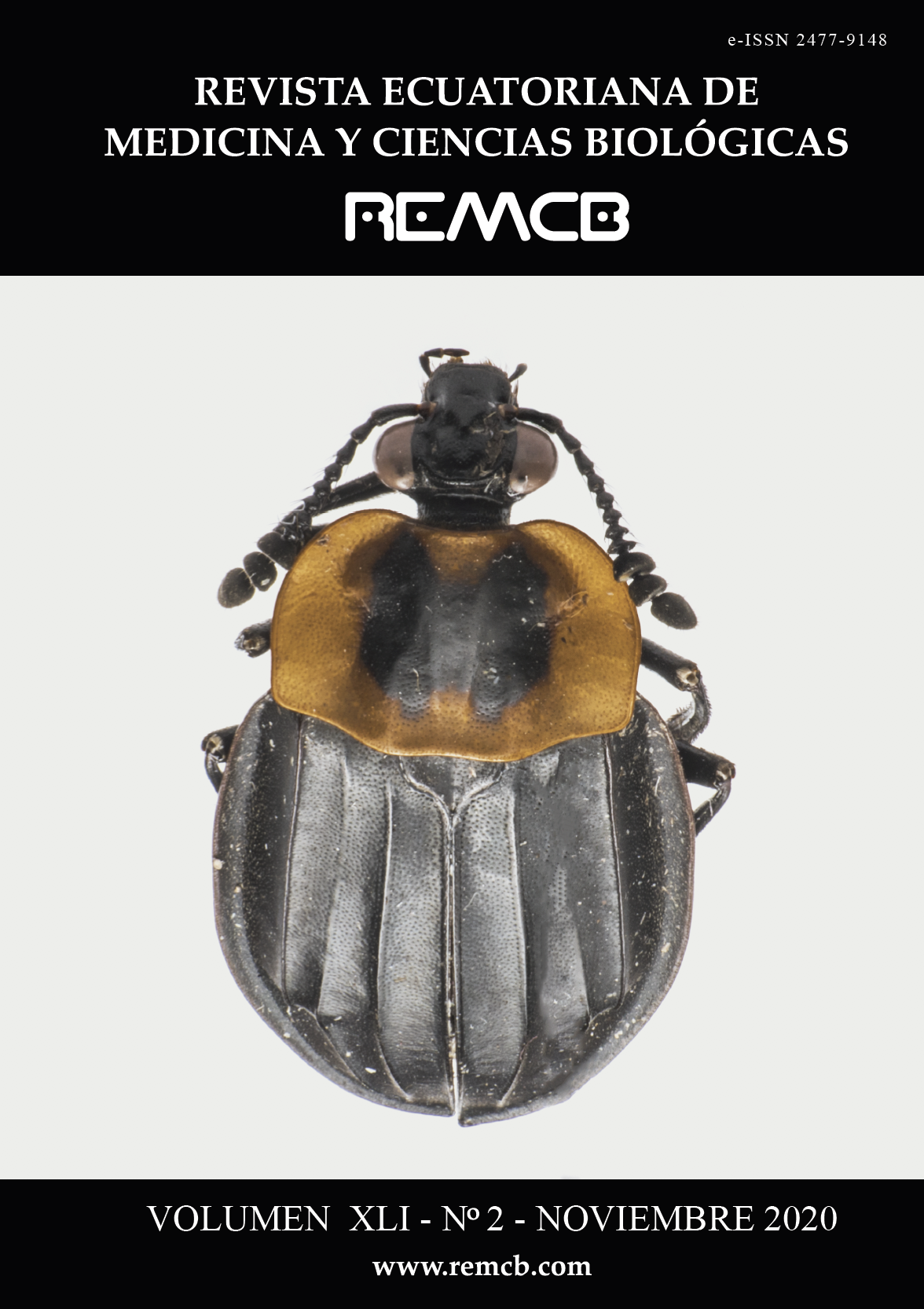Effects of radiation over fecundity in experimental populations of Drosophila melanogaster
Main Article Content
Abstract
In order to find out the effect of radiation on the fecundity of four experimental populations of Drosophila melanogaster, three of them were irradiated chronically at different absorved dose until reach a total of 1128.06Gy (Grays), the fourth one was the control. After a recuperation period, we extracted a total of 1461 second chromosomes of which we are going to refer; the extraction was done by means of the CyL/Pm technique, broadly use in similar experiments. The normal, deleterious and lethal genes from each population and its proportion varied among populations. Chromosomes were classified as carriers and non-carriers of lethal genes as well those originated naturally or induced by radiation, this grouping is the basis of our comparisons done using a “t” Student test. Average fecundity for each population was calculated and from them different categories of fecundity were stablished. Each chromosome assigned to a corresponding category in such a way to obtain the relative average frequency for each category. On every case, comparisons among chromosomes, carriers and non-carriers of lethal genes, differences always favoured those free of lethal. For radiation affect viability values and when compared with the control population they are different. When we split the average fecundity into categories was not possible to determine a pattern of distribution, that allowed us to indicate a radiation effect and we suggest as a possible cause of it, that the irradiated populations have not completely recovered and has prevented them to reach an equilibrium for their genetic structure after the damage originated by radiation, since most of these genes are in a dynamic process and are polygenic and its action is pleiotropic, they are in a process of being selected before reach a new equilibrium.
Key words: Drosophila, lethal genes, radiation, fecundity.
Downloads
Article Details
References
Ayala F. 1967. Evolution on fitness. III. Improvement of fitness in irradiated populations of Drosophila serrata. Proceedings National Academy of Sciences, United States of America 58: 1919-1923.
Band HT. 1963. Genetic structure of populations. II. Viabilities and variances of heterozygotes in constant and fluctuating environments. Evolution 17: 307-319.
Band HT. 1964. Genetic structure of populations. III. Natural selection and concealed variability in natural populations of Drosophila melanogaster. Evolution 18: 384-404.
Band HT. and Ives PT. 1963. Genetic structure of populations. I. On the nature of the genetic load in South Amberst population of Drosophila melanogaster. Evolution 17: 198-215.
Barnes AL, Neghy S, Borne J.M, Partrige L, Chapman T. 2008. Feeding, fecundity and lifespan in female Drosophila melanogaster. Proc.R.Soc. B.Biol.Sci. 275:1875-1883.
Carson HL. 1969. Maintenance of lethal and detrimental genes in natural populations. Japanese Journal of. Genetics 44 (suppl. 1): 225-227.
Da Cunha AB. 1968. Maintenance of lethal and detrimental genes in natural populations. Procedings. of the XII International. Congress of. Genetics 2: 162-163.
Curtsinger JW. 2019. Fecundity for free? enhanced oviposition in longevous populations of Drosophila melanogaster. Biogerontology 20:397-404.
Falk R. 1967. Fitness of heterozygotes in Drosophila. Mutation Research 4:805- 819.
Falk R. and Ben Zeev N. 1966. Viability of heterozygotes for induced mutations in Drosophila melanogaster. II. Mean effects in irradiated autosomes. Genetics 53: 65-77.
Fowler K, Semple C, Barton NH, Partridge LP. 1997. Genetic variation for total fitness in Drosophila melanogaster. Proceedings Biological Sciences 264: 191-199.
Gardner MP, Fowler K, Barton NH, Partridge. LP. 2005. Genetic variation for total fitness in Drosophila melanogaster. Genetics 169: 1553-1571.
Kitagawa O. 1967. Interaction in fitness between lethal genes in heterozygous condition in Drosophila melanogaster. Genetics 57: 809-820.
Mazzetto F, Gonella E, Alma A. 2015. Wolbachia infection affects female fecundity in Drosophila suzukii. Bulletin of Insectology 68 (1)153-157.
Mukai T, Yoshikawa I, Saito K. 1966. The genetic structure of natural populations of Drosophila melanogaster. IV. Heterozygous effects of radiation induced mutations on viability in various genetic backgrounds. Genetics 53: 513-527.
Petit C and Nouaud D. 1984. The maintenance of the lethal gene curly in experimental populations of Drosophila melanogaster. Heredity 53: 260-281.
Pimentel E, Tavera L, Cruces MP, Balcazar M, de la Rosa ME. 2003. Low radon-dose effect on fecundity and egg-to-adult viability of Drosophila. Radiat. Meassure 36: 511-516.
Rauser CL, Tieney JJ, Gunion SM, Covarrubias GM, Mueller lD, Rose MR. 2016. Evolution of late- life fecundity in Drosophila melanogaster, J. Evol. Biol. 19:289-301.
Salceda VM. 1967. Recessive lethals in second chromosomes of Drosophila melanogaster, with radiation stories. Genetics 57: 691-699.
Salceda VM. 1985. Viability effect of lethal and non-lethal II chromosomes of irradiated Drosophila melanogaster populations. Archives. Biologiest. Nauka, Beograd 37 (1-4): 27-32.
Salceda VM. 2005. Efecto de la exposición cronica al Radon en poblaciones experimentales de Drosophila melanogaster. Rev. Int. Contam. Ambient. 21 (3) : 125.131.
Sánchez PJL, Salceda VM, Molina J. 1874. Efecto de genes letales recesivos en posición trans en el cromosoma II de Drosophila melanogaster (Meigen) sobre algunos componentes de valor adaptativo. Agrociencia 16: 75-82.
Sankaranarayanan K. 1966. Some components of genetic load in irradiated experimental populations of Drosophila melanogaster. Genetics 54: 121-139.
Simmons MJ, Sheldom EW, Crow JF. 1978. Heterozygous effects of fitness of EMS treated chromosomes in Drosophila melanogaster. Genetics 88: 575-590.
Wallace B. 1956. Studies on irradiated populations of Drosophila melanogaster. Journal of Genetics 54:280-293.
Wallace B. 1958. The average effect of radiation induced mutations on viability in Drosophila melanogaster. Evolution 12: 532-552.
Wallace B. and Madden C. 1953. The frequency of sub an supervitals in experimental populations of Drosophila melanogaster. Genetics 38: 456-470.
Yamazaki T. 1984. Measurement of fitness and its components in six laboratory strains of Drosophila melanogaster. Genetics 108: 201-211.

